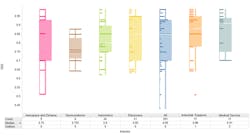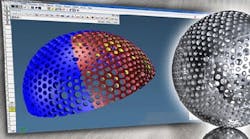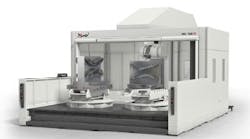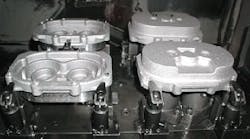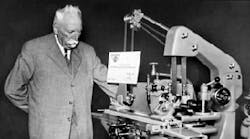Applied Test Systems Inc., maker of testing equipment for a range of applications, originally operated the company out of a closed down bar until production increases demanded a move to a building that was formerly used as a church.
The forces of change and innovation are often associated with the social and cultural setting of the 1960s. However, those forces were also prevalent in defining that same decade in the machine tool industry. In the mid-1960s, numerical control (NC) using transistor technology was introduced. Then, in 1966, integrated circuits helped NC become a more compact, realistic asset to the machine shop.
Suddenly, the machine tool industry was faced with its biggest change since individual machine motors replaced overhead shafts and belts. Manufacturers saw the price of the average machine tool at least quadruple as NCs began appearing on mills and lathes.
But one NC controlled machine could also do the work of around 8 to 10 manual machines, depending on the application.
The 1960s was the decade automation moved from its experimental phase to becoming a machine-tool necessity. The interest in controls was high by the mid and late 1960s, and many new companies took advantage of the blossoming opportunities.
Servo Products Co., started in 1964, originally made test equipment for servo controls and power feeds for milling machines. The business began when Francis Moseley, who had a large-scale model train hobby, tired of manually operating his shop's milling machine. To solve his problem, he developed a controlled power feed for his own use.
At that same time, he had also started Servo Products Co. to develop and sell servo test equipment. At a trade show where he was displaying his company's test equipment, he decided bring in his Clausing Mill to fill out the booth. Visitors were more interested in the self-contained power feed then the test equipment and wanted to know if the testing equipment was controlling the mill. They wanted a lightweight, variable-speed feed for their Bridgeport mills. And that's how Moseley and Servo Products stumbled upon their new industry focus in 1965.
Anilam Inc.'s founder, Jay Malina, knew about the high industry demand for controls for machine tools and quality assurance products due to first-hand experience. He was an electrical engineer whose father was a machine tool importer, so Malina was familiar with the industry. He recognized a need for electronic measurement systems for manual machine tools — which did not cost more than the machines themselves. So, in 1968, he started Anilam Inc., Eventually the company moved into its current business, making digital readout systems and CNC controls.
The onset of NC made manufacturers of machine tool accessories and components re-think their own industries and work towards innovation. Cutting tools, especially, adapted to work on machines that boasted higher speeds and greater rigidity. New carbide grades were introduced to match work material and insert shape, and cutting-edge angles became better defined.
In 1967, Jack Newberry saw a need for a single grade of carbide with good shock resistance, so he began experimenting with a new kind of tooling in his garage. He showed his new invention, Hi-Micro Super Carbide cutting tools, to E. Mike Bruhwiler, president of Bruhwiler Precise Sales, a retail tool distributor.
Newberry asked Bruhwiler to take him to a part of the building that had a concrete floor, and, once there, he proceeded to throw the tool onto the concrete to prove its durability and show that it would not chip or damage.
Bruhwiler says he watched the demonstration in awe and thought, "This man is crazy, I have flipped out, or Jack Newberry has made something truly valuable . . ."
Bruhwiler took on and promoted the new line, while Newberry manufactured the tools as a family business for slow and steady growth. That's how Micro 100 Inc. began selling its super carbide, single grade tools.
For Vargus Ltd., of Israel, seller of Vardex tooling, internal business, as opposed to industry demands, prompted innovation. Vargus got its start in 1960 because a difficult component was requiring better, more efficient cutting. The company's then parent firm was making stainless steel components for the dairy and wine industry, and threading the components was difficult. To solve this problem, it developed a lay-down style interchangeable insert. The company proved to be developing tooling a bit ahead of its time, however, as the inserts didn't maximize their potential until several years later. In 1980, the VNE Corp. was established as the American marketing arm of Vargus.
In the 1960s, better controls led to faster machine tools, faster machines inspired better tooling, and better tooling increased speeds, feeds, and depths of cut. All of this required better control of the cut and greater accuracy. Manufacturers could now demand tighter tolerances, but this required a new breed of inspection tools.
Most innovators in the part-inspection field got their start making quality assurance products for the science industry. Panametrics Inc., founded in 1960, was one of those innovators. The company was originally hired by the Navy, Air Force, and NASA to develop upper-atmosphere moisture and ozone measurement devices. The three founders, David Chleck, Edmund Carnevale, and Charles Ziegler each invested $300 in the new company, called Parametrics, and got started in a small office above a barber shop. Unfortunately, they soon learned the name Parametrics was taken and changed the "Para" in the name to "Pana."
As the machine tool market grew, needing more measuring devices, Panametrics shifted its focus from the scientific industry. Over the next 40 years, it introduced both the 50 and 150 MHz highly damped, broadband high-frequency transducers; precision-lapped 1 /4 wavelength faceplates on immersion transducers; contact transducers with WC-5 wearplates; and portable digital ultrasonic flaw detectors.
NCs were not the only new technology emerging from experimental stages in the 1960s. New materials and cutting methods were also gaining ground.
One such example was Poco Graphite Inc., originally a division of the Pure Oil Co. The firm initially developed a super graphite made to withstand the rigors of space travel. When the government, who funded the project, was finally satisfied with the graphite, the money dried up. But scientist Chance Vought had already established the new material in several other markets.
Poco came into its own in 1964, and within the next year, it had won an award for making a material with good electrical and heat conductivity and resistance to chemical and thermal shock at temperatures that would melt most other metals.
The company, though, expanded beyond materials in 1969, and established an EDM test lab to support one of its fastest-growing graphite applications for the machining industry. It eventually went on to sell several different models of EDMs.
While sawing was not a new method of cutting materials, the sawing market did change as automation came onto the entire metalworking scene. Hem Inc, maker of Hem Saws, was founded in the 1960s by Gerald Harris in his garage. He started out automating a Sears power hacksaw.
"People liked it, so I started building automatic barfeeders and control systems. Then I decided I could build a better bandsaw," says Harris. The company was successful for the most part. During one period, however, it did shrink down to just Harris and his wife. "I sold a saw to the Marine base in San Diego, and we had no money in the bank at all," recalls Harris. "On the way home, the truck broke down, and I had to leave my toolbox at a garage in exchange for the parts to fix my truck. When I got home, there was a check in the mailbox for the saw. I told my wife, 'we're still alive,' and I took her out to dinner." The company now designs more than 40 models of bandsaws and material-handling systems.
Companies founded in the 1960sHEM Inc. (1960), VNE Corp. (1960), Panametrics Inc. (1960), Poco Graphite Inc. (1964), Servo Products Co. (1964), Applied Test Systems Inc.(1965,) Advanced Machine & Engineering Co. (1966), Wilson Tool International Inc. (1966,) Micro 100 Inc. (1967), Anilam Inc. (1968), Hannibal Carbide Tool Inc. (1969), Nook Industries Inc. (1969) |
Richard E. LeBlond LeBlond Machine Tool Co. (Makino)
1960
LeBlond graduated from Purdue in mechanical engineering in 1922 and went to work for his father at R.K.
LeBlond Machine Tool. He led the company from 1940 to 1965 producing lathes for large caliber guns during the war. After the war he developed automated lathes for production of line and pin bearings of crankshafts. The company was involved with General Electric in developing and producing the first continuous-path numerically controlled lathe in 1960 and a low-cost NC lathe with threading capability in 1964.









